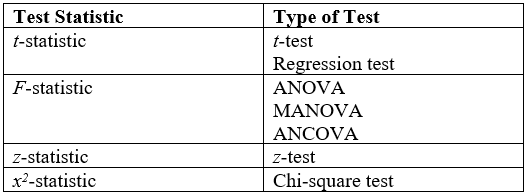|
Fisher's Method
In statistics, Fisher's method, also known as Fisher's combined probability test, is a technique for data fusion or "meta-analysis" (analysis of analyses). It was developed by and named for Ronald Fisher. In its basic form, it is used to combine the results from several independence tests bearing upon the same overall hypothesis (''H''0). Application to independent test statistics Fisher's method combines extreme value probabilities from each test, commonly known as " ''p''-values", into one test statistic (''X''2) using the formula :X^2_ = -2\sum_^k \ln p_i, where ''p''''i'' is the ''p''-value for the ''i''th hypothesis test. When the ''p''-values tend to be small, the test statistic ''X''2 will be large, which suggests that the null hypotheses are not true for every test. When all the null hypotheses are true, and the ''p''''i'' (or their corresponding test statistics) are independent, ''X''2 has a chi-squared distribution with 2''k'' degrees of freedom, where ''k'' is ... [...More Info...] [...Related Items...] OR: [Wikipedia] [Google] [Baidu] [Amazon] |
Null Distribution
Null may refer to: Science, technology, and mathematics Astronomy *Nuller, an optical tool using interferometry to block certain sources of light Computing *Null (SQL) (or NULL), a special marker and keyword in SQL indicating that a data value does not exist, is not known, or is missing. *Null character, the zero-valued ASCII character, also designated by , often used as a terminator, separator or filler. This symbol has no visual representation. * Null device, a virtual file that discards data written to it, on Unix systems /dev/null *Null pointer or reference (sometimes written NULL, nil, or None), an object pointer (or reference) not currently set to point (or refer) to a valid object Mathematics * Null (mathematics), a zero value in several branches of mathematics Physics *Null (physics), a point in a field where the field quantity is zero * Null (radio), a concept in electromagnetism Arts and media *The Null Corporation, an imprint of the band Nine Inch Nails * ''Null'' (In ... [...More Info...] [...Related Items...] OR: [Wikipedia] [Google] [Baidu] [Amazon] |
Statistical Tests
A statistical hypothesis test is a method of statistical inference used to decide whether the data provide sufficient evidence to reject a particular hypothesis. A statistical hypothesis test typically involves a calculation of a test statistic. Then a decision is made, either by comparing the test statistic to a critical value or equivalently by evaluating a ''p''-value computed from the test statistic. Roughly 100 specialized statistical tests are in use and noteworthy. History While hypothesis testing was popularized early in the 20th century, early forms were used in the 1700s. The first use is credited to John Arbuthnot (1710), followed by Pierre-Simon Laplace (1770s), in analyzing the human sex ratio at birth; see . Choice of null hypothesis Paul Meehl has argued that the epistemological importance of the choice of null hypothesis has gone largely unacknowledged. When the null hypothesis is predicted by theory, a more precise experiment will be a more severe test of t ... [...More Info...] [...Related Items...] OR: [Wikipedia] [Google] [Baidu] [Amazon] |
Cumulative Distribution Function
In probability theory and statistics, the cumulative distribution function (CDF) of a real-valued random variable X, or just distribution function of X, evaluated at x, is the probability that X will take a value less than or equal to x. Every probability distribution Support (measure theory), supported on the real numbers, discrete or "mixed" as well as Continuous variable, continuous, is uniquely identified by a right-continuous Monotonic function, monotone increasing function (a càdlàg function) F \colon \mathbb R \rightarrow [0,1] satisfying \lim_F(x)=0 and \lim_F(x)=1. In the case of a scalar continuous distribution, it gives the area under the probability density function from negative infinity to x. Cumulative distribution functions are also used to specify the distribution of multivariate random variables. Definition The cumulative distribution function of a real-valued random variable X is the function given by where the right-hand side represents the probability ... [...More Info...] [...Related Items...] OR: [Wikipedia] [Google] [Baidu] [Amazon] |
Samuel A
Samuel is a figure who, in the narratives of the Hebrew Bible, plays a key role in the transition from the biblical judges to the United Kingdom of Israel under Saul, and again in the monarchy's transition from Saul to David. He is venerated as a prophet in Judaism, Christianity, and Islam. In addition to his role in the Bible, Samuel is mentioned in Jewish rabbinical literature, in the Christian New Testament, and in the second chapter of the Quran (although the text does not mention him by name). He is also treated in the fifth through seventh books of ''Antiquities of the Jews'', written by the Jewish scholar Josephus in the first century. He is first called "the Seer" in 1 Samuel 9:9. Biblical account Family Samuel's mother was Hannah and his father was Elkanah. Elkanah lived at Ramathaim in the district of Zuph. His genealogy is also found in a pedigree of the Kohathites (1 Chronicles 6:3–15) and in that of Heman the Ezrahite, apparently his grandson (1 Chronic ... [...More Info...] [...Related Items...] OR: [Wikipedia] [Google] [Baidu] [Amazon] |
Statistical Power
In frequentist statistics, power is the probability of detecting a given effect (if that effect actually exists) using a given test in a given context. In typical use, it is a function of the specific test that is used (including the choice of test statistic and significance level), the sample size (more data tends to provide more power), and the effect size (effects or correlations that are large relative to the variability of the data tend to provide more power). More formally, in the case of a simple hypothesis test with two hypotheses, the power of the test is the probability that the test correctly rejects the null hypothesis (H_0) when the alternative hypothesis (H_1) is true. It is commonly denoted by 1-\beta, where \beta is the probability of making a type II error (a false negative) conditional on there being a true effect or association. Background Statistical testing uses data from samples to assess, or make inferences about, a statistical population. Fo ... [...More Info...] [...Related Items...] OR: [Wikipedia] [Google] [Baidu] [Amazon] |
Diabetes
Diabetes mellitus, commonly known as diabetes, is a group of common endocrine diseases characterized by sustained high blood sugar levels. Diabetes is due to either the pancreas not producing enough of the hormone insulin, or the cells of the body becoming unresponsive to insulin's effects. Classic symptoms include polydipsia (excessive thirst), polyuria (excessive urination), polyphagia (excessive hunger), weight loss, and blurred vision. If left untreated, the disease can lead to various health complications, including disorders of the cardiovascular system, eye, kidney, and nerves. Diabetes accounts for approximately 4.2 million deaths every year, with an estimated 1.5 million caused by either untreated or poorly treated diabetes. The major types of diabetes are type 1 and type 2. The most common treatment for type 1 is insulin replacement therapy (insulin injections), while anti-diabetic medications (such as metformin and semaglutide) and lifestyle modificatio ... [...More Info...] [...Related Items...] OR: [Wikipedia] [Google] [Baidu] [Amazon] |
Effect Size
In statistics, an effect size is a value measuring the strength of the relationship between two variables in a population, or a sample-based estimate of that quantity. It can refer to the value of a statistic calculated from a sample of data, the value of one parameter for a hypothetical population, or to the equation that operationalizes how statistics or parameters lead to the effect size value. Examples of effect sizes include the correlation between two variables, the regression coefficient in a regression, the mean difference, or the risk of a particular event (such as a heart attack) happening. Effect sizes are a complement tool for statistical hypothesis testing, and play an important role in power analyses to assess the sample size required for new experiments. Effect size are fundamental in meta-analyses which aim to provide the combined effect size based on data from multiple studies. The cluster of data-analysis methods concerning effect sizes is referred to as estima ... [...More Info...] [...Related Items...] OR: [Wikipedia] [Google] [Baidu] [Amazon] |
Harmonic Mean P-value
The harmonic mean ''p''-value (HMP) is a statistical technique for addressing the multiple comparisons problem that controls the strong-sense family-wise error rate (this claim has been disputed). It improves on the power of Bonferroni correction by performing combined tests, i.e. by testing whether ''groups'' of ''p''-values are statistically significant, like Fisher's method. However, it avoids the restrictive assumption that the ''p''-values are independent, unlike Fisher's method. Consequently, it controls the false positive rate when tests are dependent, at the expense of less power (i.e. a higher false negative rate) when tests are independent. Besides providing an alternative to approaches such as Bonferroni correction that controls the stringent family-wise error rate, it also provides an alternative to the widely-used Benjamini-Hochberg procedure (BH) for controlling the less-stringent false discovery rate. This is because the power of the HMP to detect significant ''g ... [...More Info...] [...Related Items...] OR: [Wikipedia] [Google] [Baidu] [Amazon] |
T Approximation
T, or t, is the twentieth letter of the Latin alphabet, used in the modern English alphabet, the alphabets of other western European languages and others worldwide. Its name in English is ''tee'' (pronounced ), plural ''tees''. It is derived from the Semitic Taw 𐤕 of the Phoenician and Paleo-Hebrew script (Aramaic and Hebrew Taw ת/𐡕/, Syriac Taw ܬ, and Arabic ت Tāʼ) via the Greek letter τ (tau). In English, it is most commonly used to represent the voiceless alveolar plosive, a sound it also denotes in the International Phonetic Alphabet. It is the most commonly used consonant and the second-most commonly used letter in English-language texts. History ''Taw'' was the last letter of the Western Semitic and Hebrew alphabets. The sound value of Semitic ''Taw'', the Greek alphabet Tαυ (''Tau''), Old Italic and Latin T has remained fairly constant, representing in each of these, and it has also kept its original basic shape in most of these alphabets. Use ... [...More Info...] [...Related Items...] OR: [Wikipedia] [Google] [Baidu] [Amazon] |
Multivariate Normal Distribution
In probability theory and statistics, the multivariate normal distribution, multivariate Gaussian distribution, or joint normal distribution is a generalization of the one-dimensional ( univariate) normal distribution to higher dimensions. One definition is that a random vector is said to be ''k''-variate normally distributed if every linear combination of its ''k'' components has a univariate normal distribution. Its importance derives mainly from the multivariate central limit theorem. The multivariate normal distribution is often used to describe, at least approximately, any set of (possibly) correlated real-valued random variables, each of which clusters around a mean value. Definitions Notation and parametrization The multivariate normal distribution of a ''k''-dimensional random vector \mathbf = (X_1,\ldots,X_k)^ can be written in the following notation: : \mathbf\ \sim\ \mathcal(\boldsymbol\mu,\, \boldsymbol\Sigma), or to make it explicitly known that \mathb ... [...More Info...] [...Related Items...] OR: [Wikipedia] [Google] [Baidu] [Amazon] |



